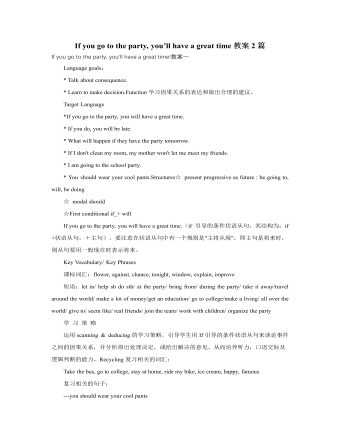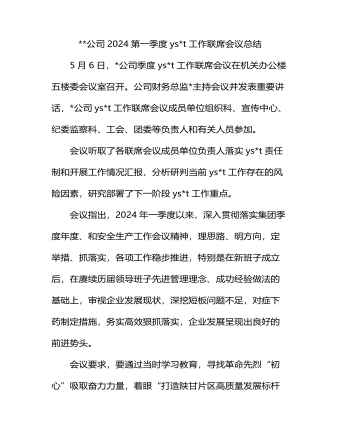人教版新目标初中英语八年级下册Would you mind turning down the music教案
-
- 页数:9页
- 字数:约 11490 字
- 大小:53.50KB
- 格式:.doc
- 版本:Office2016及以上版本
- 作者:Inge设计
Would you mind turning down the music教案
Language goals:
In this unit students learn to make requests andto apologize…
New languages:
Would you mind cleaning your room?
Would you mind not playing baseball here?

Could you please take out the trash?
You have to do your homework.
I’m sorry. I’ll do it right away.
Sorry. We’ll go and play in the park.
No, not at all.
Sure. That’s no problem.
Difficult points:
1. How to make requests with “Would youmind…?”structure.
2. How to give responses to the requests “Wouldyou mind…?”
& “Could you…?”
3. How to deal with the difficulties in orderingthings.
4. Make requests about the given situations.
5. Help students to find the topic sentence ineach paragraph.
Teaching aids:
A tape recorder/ Some pictures
Teaching periods:
Period 1: Section A 1a, 1b, 1c
Period 2: Section A 2a, 2b, 2c
Period 3: Section A 3a, 3b, 4
Period 4: Section B 1a, 1b, 1c, 2a, 2b, 2c
Period 5: Section B 3a, 3b, 4, Self check
Period 6: Extensive reading
Period 1
Teaching aims:
1. Teach vocabulary words and the usefulexpressions.
2. Target languages:
Would you mind turning down the music?
No, not at all.
Would you mind moving your bike?
Sorry. I’ll do it right away.
3. Enable the students to make requests.
4. Help the student learn how to make requests.
Teaching procedures:
Step 1. Warming up
Write the following requests on the Bb:
Can you give me the book?
Please give me the book.
Would you mind giving me your book?
Say, the last example is a very polite way ofmaking a request.
Write down the title of this unit on theblackboard.
Ask students to make sentences using “Would youmind …?”structure.
Explain to the students that the –ing form shouldbe used after the verb mind.
Step 2. Presentation (1a)
1. Point to the four requests in the box. Askstudents to read them together.
2. Point to the picture. Ask the students to matchthe requests with the people in
the picture.
3. Check the answers with the whole class.
Step 3. Listening (1b)
1. Ask students to listen to the tape and understandthe target language of making requests.
2. Play the tape again and ask them to number therequests in the order they hear.
3. Check the answers with the whole class.
Step 4. Pair work (1c)
1. Ask students to read the dialogue in activity1c.
2. Ask students to make requests with theirpartners.
3. Ask some pairs to say their conversations tothe class.
Step 5. Homework
Try to get as many ways of asking for requests aspossible.
Period 2
Teaching aims:
1. Learn the vocabulary words and useful expressions.
2. Target languages:
Would you mind doing the dishes / cleaning yourroom / not wearing those old jeans / getting out of the bathroom / getting up?
Sorry. It won’t be long.
OK. I’ll do them in a minute.
I’m sorry. I’ll do it right away.
3. Enable the students to make responses torequests.
4. Help the student learn how to response torequests.
Teaching procedures:
Step 1. Revision
Ask students to make more sentences with the“Would you
mind…?”structure.
Step 2. Listening (2a, 2b)
1. Ask students to listen to the tape andunderstand the target language of
making requests in activity 1a.
2. Play the recording a second time. Ask Ss tonumber the pictures in the order they hear.
3. Check the answers with the whole class.
4. Point out the five responses in activity 2b.Ask students to read them.
5. Play the recording. This time ask Ss to fill inthe letters of the pictures
in front of the responses.
6. Check the answers.
Step 3. Pair work (2c)
Askstudents to do some oral practice about making requests and giving responseslike this about the information above.
Step 4. Grammar
Ask the students to read the sentences in thegrammar box.
Help the students sum up how to make requests andresponses.
Step 5. Homework
1. Kate is still sleeping in bed. Her mother hasto go to work. She wants Kate to do the dishes, clean the room, buy some foodand do the cooking. Help her mother to write a note about it.
2. Translate the following into English.
a) 你介意把门关上吗?好的,我马上就办。
b) 你介意把收音机关小点儿声吗?不,一点也不。
c) 请不要在教室里大声说话好吗?对不起。
Period 3
Teaching aims:
1. Teach vocabulary words and the usefulexpressions.
2. Target languages:
Your father is at a meeting and I’m goingshopping.
I need your help.
If you finish these tasks, we can go to a movietonight.
You have to help me in the kitchen.
Yes, and you have to help me make dinner.
When I finish, could you help me with my homework.
3. Enable the students to use “Would you mind…?”“Could you…?” to ask for requests.
4. Help the students learn how to ask for requestswith the target language.
Teaching procedures:
Step 1. Revision
Review the structure of making requests and givingresponses by asking students some questions.
Step 2. Compliment (3a)
1. Point to the pictures. Read the instructions.Ask students to talk about what
the boy is doing in each picture.
2. Point to the note. Ask Ss to read the note andfill in answers according to the
pictures.
3. Check the answers by asking some students toread out their work.
Step 3. Pair work (3b)
1. Ask two students to read the sample dialogue in3b.
2. Ask students to read the orders in the box onthe left.
3. Ask students to make dialogues with “wouldyou”, “could you” and “have to” according to the orders.
4. Ask several pairs to say one of their conversationsto the class.
Step 4. Group work (4)
1. Ask students to read the instructions inactivity 4.
2. Ask students to finish the chart.
3. Have students make conversations according tothe chart.
4. Ask a few students to share the sampleconversation.
Step 5. Homework
Make more conversations using “would you”, “couldyou” and “have to”.
Period 4
Teaching aims:
1. Teach vocabulary words and the usefulexpressions.
2. Target languages:
Your barber gave you a terrible haircut.
The pen you bought didn’t work.
The store clerk gave you the wrong size.
The waitress brought you the wrong food.
3. Enable the students to make complaints and makerequests.
4. Help the students learn how to make complaintsand make requests.
Teaching procedures:
Step 1. Lead-in
Greet the students.
Check the homework.
Teach the students the new words in this period.
Step 2. Reading and writing (1a, 1b)
Ask students to do activity 1a.
1. Read the instruction and ask Ss to read eachsituation and think about the two
questions.
2. Ask some students to share their answers withthe class. Ask other students
whether they agree with the opinions or not.
3. Ask students to read the pictures and talkabout them. Help them understand
the pictures clearly.
Ask students to do activity 1b.
1. Ask students to talk about what they havecomplained about.
2. Have students write all the ideas down in theirexercise books.
3. Collect all the complaints from the studentsand write them on the blackboard.
4. Rank the items from the most to the leastannoying.
Step 3. Listening (2a, 2b)
Let students do activity 2a.
1. Ask students to listen to the tape. Answer anyquestions they have about the
recording.
2. Play the tape again and students number thesentences in the order they hear
them.
3. Correct the answers with the whole class.
Let students do activity 2b.
1. Ask students to read the three column headings.
2. Have students discuss what each heading means.
3. Play the tape. Students listen and write theplaces, problems and solutions in the chart.
4. Play the tape again. Stop for answers ifnecessary.
5. Check the answers with the whole class.
Step 4. Pair work (2c)
1. Ask two students to role play the dialogues in2c.
2. Ask students to look at the problems in 2b.Make students work with their partner and role play similar requests about theproblems.
3. Ask several pairs of students to say theirconversations to the class.
Step 5. Homework
Talk about some of the annoying things. Makedialogues about one of them.
Period 5
Teaching aims:
1. Teach vocabulary words and the usefulexpressions.
2. Target languages:
I don’tlike waiting in line when a shop assistant has a long telephone conversation.
Could youplease not follow me around?
I’ll askyou if I need some help.
I getannoyed when someone stands in the subway door.
Would youmind helping me?
3. Enable the students to make requests when theyget annoyed.
4. Help the students learn how to make requestswhen they get annoyed.
Teaching procedures:
Step 1. Revision and lead-in
Ask students to turn to page 55 and look at 2b.Ask them some questions. For example: What will you say to the clerk if he orshe gets you a wrong
size shirt?
Step 2. Reading (3a)
1. Play the recording of the article and have themrepeat.
2. Ask students to write the words down that theydon’t understand.
3. Ask students to underline the things that areannoying.
4. Have the students circle what people do whensomething annoying
happen.
5. Correct the answers with the class.
您可能喜欢的文档
查看更多
人教版新目标初中英语八年级下册Would you mind turning down the music说课稿8篇
- 页数:36页
- |大小:203.50KB

人教版新目标初中英语八年级下册If you go to the party, you’ll have a great time教案2篇
- 页数:25页
- |大小:200.00KB

人教版新目标初中英语八年级下册What were you doing when the UFO arrived教案2篇
- 页数:12页
- |大小:106.50KB

人教版新目标初中英语八年级下册Will people have robots教案
- 页数:26页
- |大小:231.50KB

人教版新目标初中英语八年级下册If you go to the party, you’ll have a great time说课稿9篇
- 页数:32页
- |大小:189.50KB

人教版新目标初中英语八年级下册How long have you been collecting shells教案2篇
- 页数:33页
- |大小:183.00KB

人教版新目标初中英语八年级下册Have you ever been to an amusement park教案
- 页数:10页
- |大小:113.00KB
热门课件教案

2023年区实施乡村振兴战略工作总结
- 页数:6页
- |大小:27.90KB
- 课件教案

XX区民政局党支部开展主题教育工作情况总结报告
- 页数:3页
- |大小:24.47KB
- 课件教案

县综合行政执法局2023年工作总结和2024年工作计划
- 页数:8页
- |大小:28.37KB
- 课件教案

交通运输局在巡回指导组主题教育阶段性工作总结推进会上的汇报发言
- 页数:4页
- |大小:33.41KB
- 课件教案

镇2023年工作总结和2024年工作谋划
- 页数:6页
- |大小:31.68KB
- 课件教案

公司2024第一季度意识形态工作联席会议总结
- 页数:6页
- |大小:141.67KB
- 课件教案
今日更新

5月份主题教育工作情况总结汇报
- 页数:3页
- |大小:136.87KB

××县招商局2024年上半年工作总结
- 页数:12页
- |大小:142.54KB

×××公安局机关党委上半年党建工作总结
- 页数:7页
- |大小:186.25KB

《2019—2024年全国党政领导班子建设规划纲要》实施情况的工作总结3800字
- 页数:6页
- |大小:29.16KB

“转观念、勇担当、新征程、创一流”主题教育活动阶段性工作总结
- 页数:3页
- |大小:22.76KB

“四零”承诺服务创建工作总结
- 页数:5页
- |大小:39.83KB











